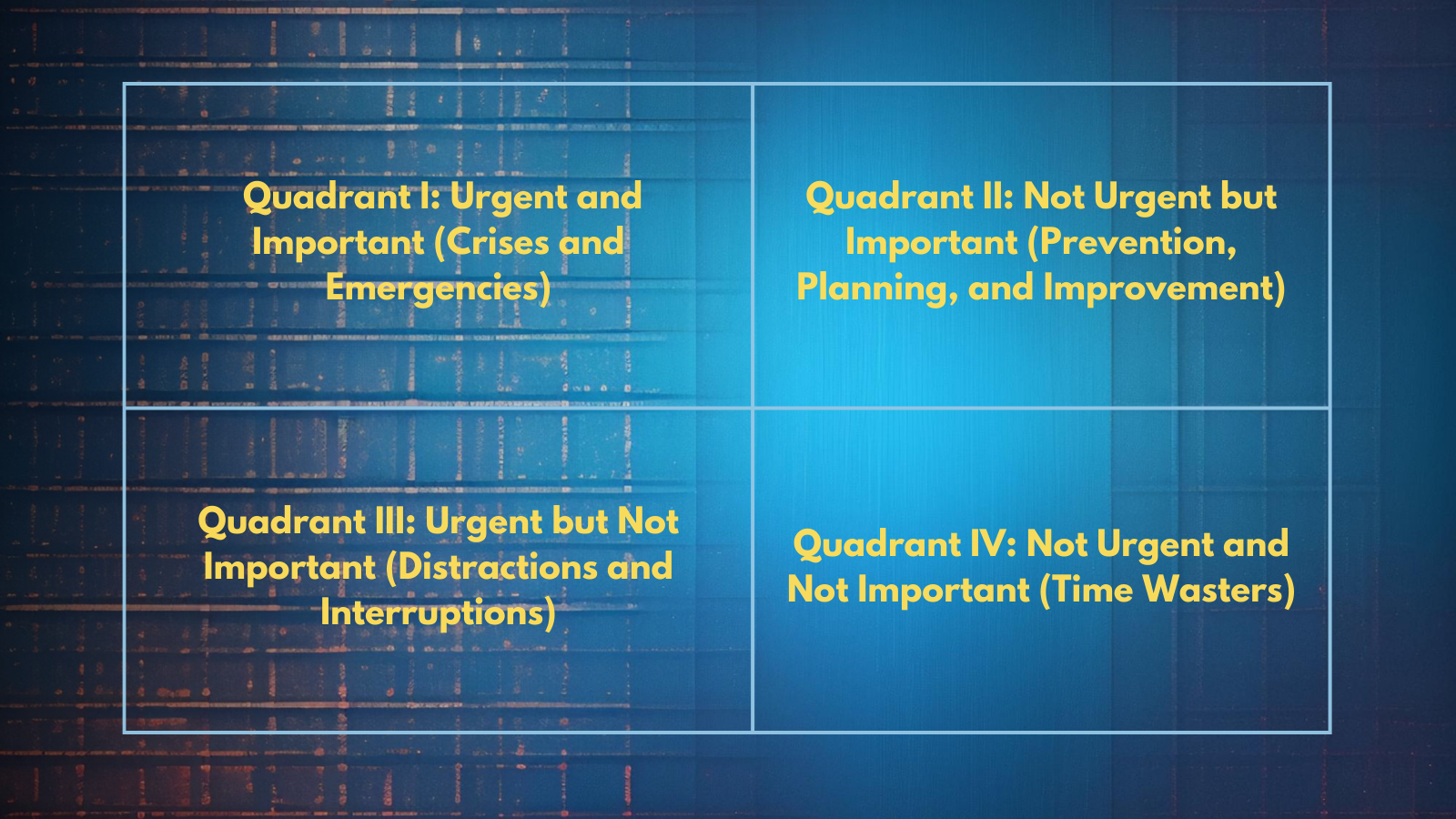Do you ever find yourself struggling to keep up with the demands of your busy schedule? If so, you’re not alone. The constant barrage of tasks and distractions can make us feel overwhelmed and unproductive. In such a hectic environment, effective time management becomes crucial. That’s where the time management matrix comes in. This powerful tool offers a structured approach to organizing your tasks and priorities, empowering you to make the most out of your time and energy.
In this blog, we’ll embark on a journey to unravel the mysteries of the time management matrix, exploring its four quadrants and uncovering the secrets to efficient time utilization. From urgent crises demanding immediate attention to long-term strategies for success, each quadrant holds valuable insights for reclaiming your time and achieving your goals. So, are you ready to take the first step towards a more organized, productive, and fulfilling life? Let’s dive in.
In a hurry? Listen to the blog instead!
Concept Of Time Management Matrix
A time management matrix serves as a tool for classifying tasks according to their urgency and importance, enabling us to prioritize efficiently. The underlying concept of this matrix acknowledges that tasks vary in significance, and by concentrating on the appropriate ones, we can attain superior outcomes in a shorter timeframe.
The matrix consists of four sections, which we will be covering later in this article:
Quadrant 1: Tasks that are Urgent and Important
Quadrant 2: Tasks that are Not Urgent but Important
Quadrant 3: Tasks that are Urgent but Not Important
Quadrant 4: Tasks that are Not Urgent and Not Important
The Origins Of The Time Management Matrix
The time matrix, popularized by Stephen Covey in his influential book “The 7 Habits of Highly Effective People,” is based on the Eisenhower Matrix. The Eisenhower Matrix, in turn, is named after Dwight D. Eisenhower, the 34th President of the United States, who was known for his exceptional time management skills.
The following quote, often attributed to Dwight D. Eisenhower, encapsulates the essence of the matrix: “I have two kinds of problems, the urgent and the important. The urgent are not important, and the important are never urgent.”
Stephen Covey adapted and further developed this idea in his book, first published in 1989. Covey’s time management matrix categorizes tasks based on urgency and importance, helping individuals prioritize their activities effectively. The matrix has become a popular tool for personal development, productivity training, and time management practices. Many employee productivity monitoring tools use this concept to allocate tasks.
What Are The Four Quadrants Of The Time Management Matrix
The time management matrix divides tasks into four distinct quadrants based on their urgency and importance:
Quadrant I: Urgent And Important (Crises And Emergencies)
In this quadrant, individuals must give immediate attention to tasks that are both urgent and important. It includes critical deadlines, pressing issues, and unforeseen emergencies.
However, excessive time spent in this quadrant can result in burnout and a continuous crisis management cycle.
When you’re in a constant state of urgency, it’s vital to take a step back and evaluate why these tasks are constantly becoming urgent. This reflection helps identify root causes and enables proactive measures to prevent the recurrence of urgent situations.
This self-analysis reduces the time spent on Quadrant I tasks while encouraging a more balanced and sustainable approach to workload management. By addressing the underlying issues, individuals can break free from the perpetual urgency cycle and cultivate a more proactive and efficient work strategy.
Quadrant II: Not Urgent But Important (Prevention, Planning, And Improvement)
Quadrant II revolves around important yet non-urgent tasks, emphasizing proactive activities like long-term planning, goal setting, and personal development, all contributing to sustained success.
Investing time in Quadrant II facilitates proactive decision-making critical for personal and professional growth, even though these tasks lack immediate deadlines. Allocating dedicated time to Quadrant II activities not only prevents urgency but also minimizes the overall time spent in the crisis-driven environment of Quadrant I.
Engaging with Quadrant II tasks demands discipline, especially amid the urgency of Quadrant I. Establishing specific time blocks for these activities and treating them as non-negotiable commitments fosters a proactive mindset. This approach ensures consistent attention to long-term objectives and promotes a balanced and effective approach to time management.
Quadrant III: Urgent But Not Important (Distractions And Interruptions)
Tasks in this quadrant of the time management matrix demand immediate attention but may not significantly contribute to long-term goals. Examples include unnecessary meetings, phone calls, and interruptions that divert attention from crucial matters.
Tasks in Quadrant III demand immediate attention but may not significantly contribute to long-term goals, encompassing activities such as unnecessary meetings, phone calls, and interruptions that divert attention from crucial matters.
Minimizing time spent in this quadrant is crucial for maintaining focus and productivity. Strategies such as delegating or outsourcing Quadrant III tasks can save time and energy. Identifying tasks that can be delegated to others, automating specific processes, or setting up efficient systems can help minimize the time spent in Quadrant III.
For instance, in an organizational context, manual attendance tracking and leave management can be efficiently handled by employee monitoring software like EmpMonitor, allowing employees to focus on more crucial, strategic tasks.
Quadrant IV: Not Urgent And Not Important (Time Wasters)
Quadrant IV involves activities that are neither urgent nor important. Individuals should consider these tasks as time-wasting and minimize or eliminate them. Examples include excessive social media browsing, certain forms of entertainment, and other non-essential activities.
Benefits Of Using The Time Management Matrix
Effective utilization of the time management matrix offers several compelling benefits, contributing to a more organized and productive work routine.
Increased Productivity:
Implementing the matrix enhances productivity by providing a structured framework for task prioritization. Individuals can focus energy on high-priority activities by categorizing tasks according to urgency and importance, resulting in more efficient and productive outcomes.
Better Prioritization Of Tasks:
The matrix facilitates a clear understanding of task urgency and importance, enabling individuals to prioritize effectively. This clarity aids in allocating time and resources to tasks that align with overarching goals, preventing undue focus on less critical activities.
Reduced Stress:
With improved task prioritization and a proactive approach to time management, individuals experience reduced stress and overwhelm. By addressing critical tasks on time and preventing last-minute crises, the overall workload becomes more manageable, fostering a healthier work-life balance.
How To Implement The Time Management Matrix
Understanding the time management matrix is just the first step. Effectively incorporating it into your daily routine requires a strategic approach. Here’s a guide on how to use this matrix for optimal results:
Identify All Tasks:
Start by compiling a comprehensive list of all tasks that need completion. It includes work-related assignments, personal responsibilities, and other activities demanding your attention.
Categorize Tasks Based On Urgency And Importance:
After identifying tasks, categorize them according to the time management matrix. Assess each task’s urgency and importance, placing them in the respective quadrants to provide a clear overview of your workload.
Prioritize Tasks:
Once tasks are categorized, prioritize them based on their quadrant. Quadrant I tasks usually take precedence, followed by Quadrant II for long-term planning and essential activities. Be mindful of focusing on high-priority tasks to ensure efficient use of time.
Create A Schedule:
Create a daily or weekly schedule based on your priority tasks. Allocate specific time blocks for each quadrant to ensure a balanced distribution of effort between urgent and important and non-urgent but critical activities.
Flexibility Is Key:
Recognize that unexpected events may arise, and priorities may shift. Stay flexible and be ready to adapt your schedule as needed while focussing on the overall goals.
Incorporate Distraction Blockers:
Implement distraction-blocking techniques to maintain focus during dedicated work periods. Utilize tools and strategies to minimize interruptions, allowing more effective time management.
By consistently applying the time management matrix, individuals can navigate their responsibilities more effectively, making informed decisions about allocating their time and energy. This proactive approach fosters a sense of control over tasks, ultimately leading to enhanced productivity and achievement of long-term objectives.
Revolutionize Time Management With EmpMonitor
To complement the principles of the time management matrix, integrating time tracking tools like EmpMonitor into your workflow can further enhance your ability to manage time effectively. Here’s how EmpMonitor aligns with the vital concepts discussed:
Real-time Task Tracking: Witness your tasks unfold in real-time, gaining insights into the nuances of your workflow and time allocation.
Data-driven Analysis: The analytics feature empowers users to delve into productivity metrics, aiding in categorizing tasks based on urgency and importance.
Distraction Monitoring: Say goodbye to unnecessary diversions as EmpMonitor tracks non-work-related activities, fostering a focused work environment in line with the principles of the time matrix.
Automated Attendance and Leave Management: Streamline administrative tasks with automated attendance tracking and leave management. It ensures accuracy and frees up valuable time for more strategic endeavors.
Productivity Reports: Gain in-depth insights into individual and team productivity through detailed reports. This feature allows for a comprehensive understanding of task efficiency, contributing to informed decision-making.
Enhanced Productivity with Website and App Blocking: This productivity monitoring software empowers users to boost productivity by blocking distracting websites and applications during dedicated work periods. This proactive approach aligns seamlessly with the blog’s emphasis on minimizing Quadrant III distractions.
Screenshot and Keystroke Logging: For tasks that require a closer examination, EmpMonitor offers screenshot and keystroke logging capabilities. This feature ensures accountability and assists in identifying areas for improvement, aligning with the overall goals of effective time management.
By embracing EmpMonitor’s multifaceted capabilities, individuals enhance their time management practices and establish a proactive and efficient work culture. It’s more than a tool; it’s a comprehensive strategy for elevating productivity and achieving long-term objectives.
Experience the power of data-driven insights and seamless workforce management to stay ahead in today’s dynamic work environment.
Read More
Why You Must Have Time Management Skills In 2022
How To Improve Productivity And Efficiency With Time Management Software?
How To Improve Your Time Management Goal With Examples
Summary
The time management matrix offers a strategic approach to task prioritisation, fostering productivity and stress reduction. Navigating its four quadrants provides insights into urgency, importance, and transformative potential. By mastering this matrix, individuals gain control over their time, ensuring efficient allocation to high-priority tasks.
Complementing these principles, innovative tools like EmpMonitor enhance productivity and align seamlessly with the matrix’s proactive strategies. Revolutionize time management, minimize stress, and cultivate a more productive life. It’s a journey of empowerment, where each quadrant becomes a stepping stone to success.














